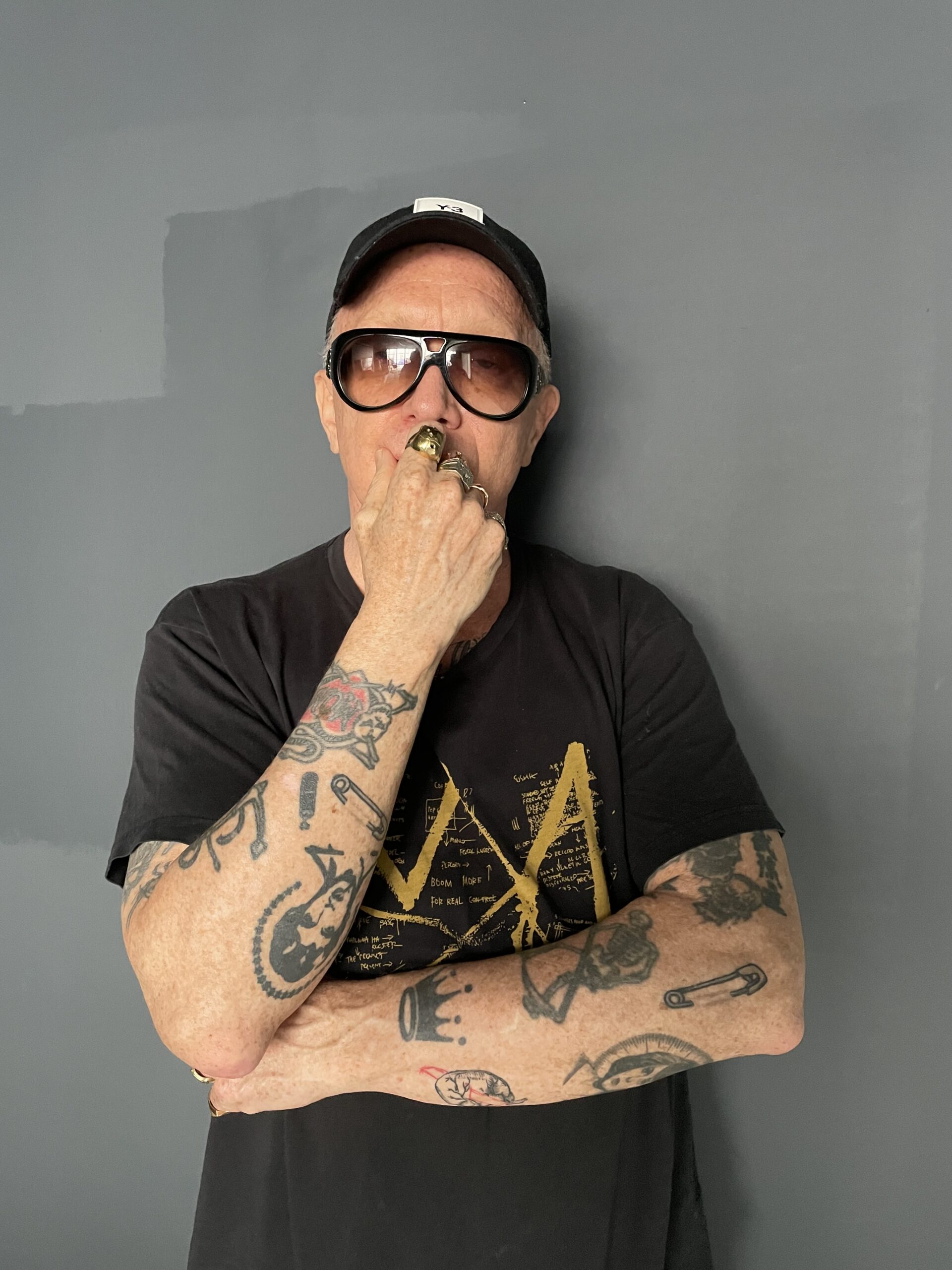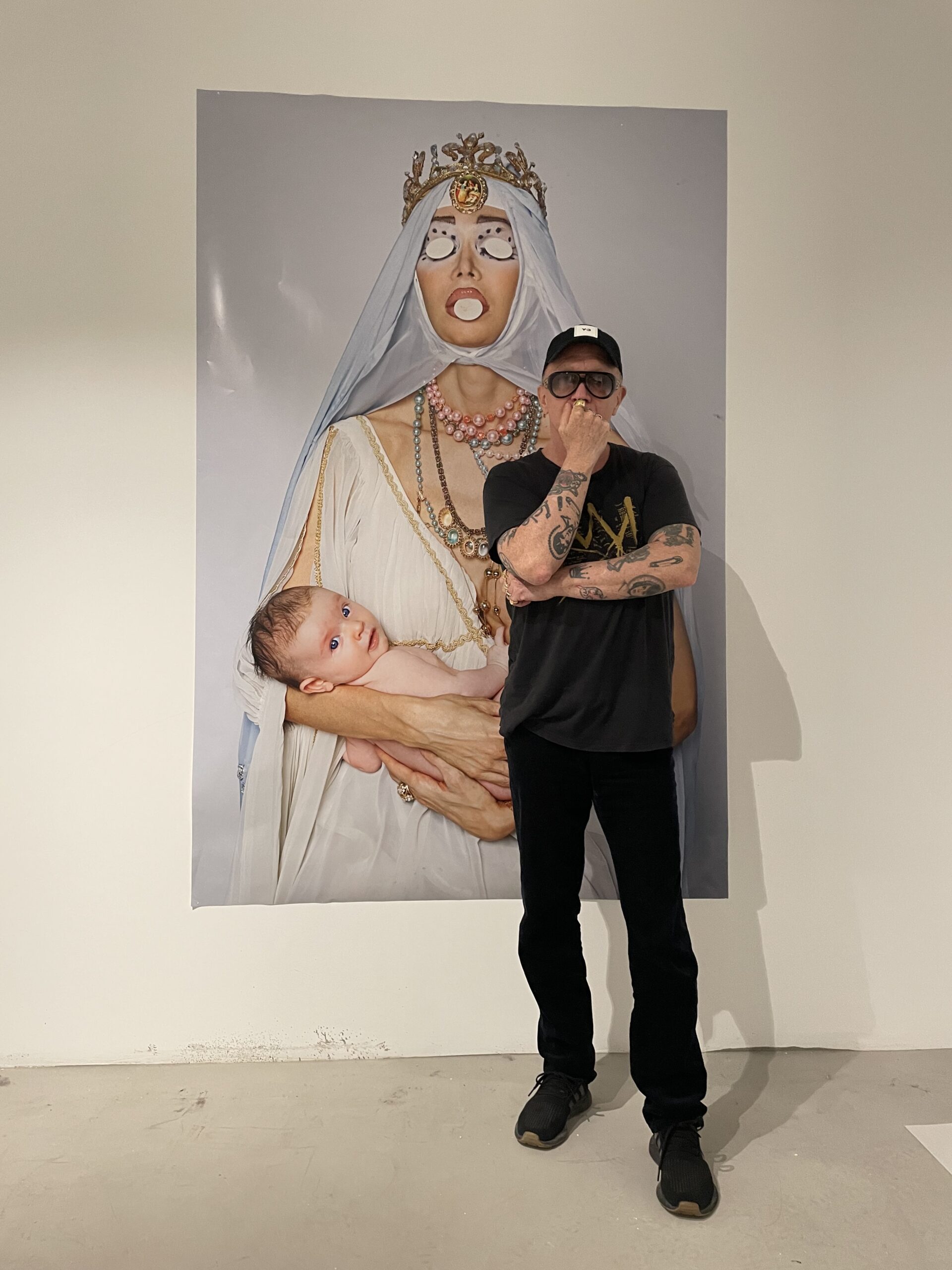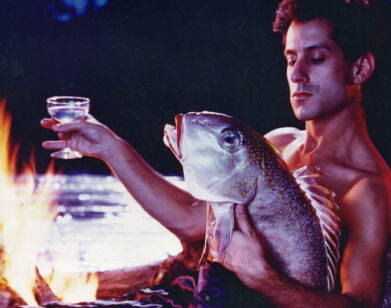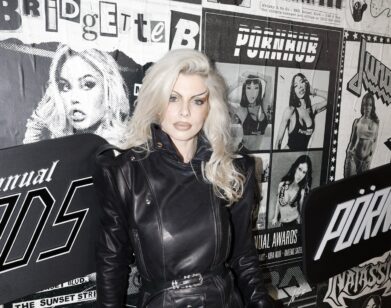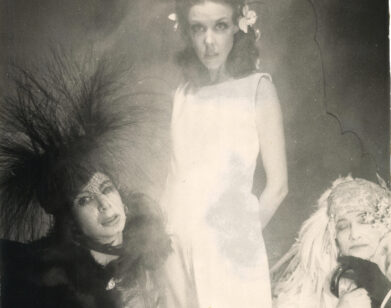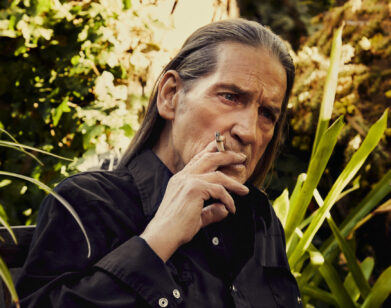icon
Bruce LaBruce on Billionaires, iPhones, and His Porno Pasolini Remake
Every second of every day, over 28,000 people are watching pornography on the internet. Much has been much written about the dangers of porn, but little mention is made of its role in the sexual liberation of women or queer folks. Before meeting the Canadian filmmaker and provocateur Bruce LaBruce in a former bacon factory in South East London, I could find no consensus about the definition of porn, let alone any hard and fast distinctions between the “bad” kind and the “ethical” kind.
I felt sure that Mr. LaBruce, after three decades of mixing art house and pornographic techniques in his own filmmaking, might have a good idea. The 59-year-old even performed his own sex scenes with his then-boyfriend in his debut feature film, 1991’s No Skin Off My Ass. The cult-celebrated polymath thrives on breaking with tradition in his work, an oeuvre that’s at once campy, sleazy, political, transgressive, and unabashedly absurd. His latest project, The Visitor, a pornographic remake of Pier Paolo Pasolini’s 1968 film Teorema presented by the London-based arts organization a/political, is the perfect example. In the original film, a mysterious stranger shows up at the doorstep of an upper-middle-class Milanese family and proceeds to sexually entrance every single member before departing, wreaking havoc in his wake. In LaBruce’s remake, the British public was invited to witness the production itself, the audience made into voyeurs as they watched a live three-way sex scene through peepholes. Just after the final cut was unveiled, LaBruce and I met at his apartment above the venue to discuss the politics of gay liberation, Pasolini’s legacy, and whether smartphones turned us into narcissists.
———
JAD SALFITI: You’re an artist who has worked in many different mediums. Do you think when an artist reaches a level of wealth, fame, it becomes harder to create interesting work?
BRUCE LABRUCE: I think that there’s a lot of people now who become so famous and so rich, so fast, that they become too big to fail. In the olden days, people had a lot more career ups and downs and they kind of go bankrupt and have to struggle to come back. And maybe some of the struggles force them to be super creative or try different things. I think you can get complacent when you’re in that position of not having to worry about anything for the rest of your life.
SALFITI: Speaking of, do you think billionaires should exist?
LABRUCE: No. I’m more into the distribution of wealth idea. I mean, they certainly have the right to be billionaires, but they should be taxed more. There should be more regulations on the financial sector so that people can’t infinitely and exponentially grow their wealth to a point of being this kind of uber-class. It’s like a class of people who really run the world now.
SALFITI: So, where are we right now?
LABRUCE: I could give you a tour. So this is a/political. I met them through this magazine, it’s called Doesn’t Exist. Each issue is dedicated to a different artist or filmmaker, so they’ve done one on Peter Greenaway, John Waters, Michelangelo Antonioni. They approached me to do this book. They work with Andres Serrano and Cassils, and Franko B., and Pyotr Pavlensky, the Russian artist who famously nailed his balls to Red Square and does really provocative art. They work with an artist who does roadkill, like, he cooks and eats roadkill. They really liked my work, so we decided to make this movie that doesn’t exist, this reimagining of Pasolini. I’m kind of in-residence, upstairs, there’s a little apartment.
SALFITI: Why Pasolini?
LABRUCE: For me, the art filmmakers from the ’70s, the ’60s, that were hugely influential were queer filmmakers, like Pasolini and [Rainer Werner] Fassbinder and John Waters. I’ve always been inspired by his films, the fact that he was a Marxist, he was also deeply spiritual, and interested in religion. He was a very dialectical thinker, who embodied a lot of things that are seemingly contradictory, but somehow made sense of them, and allowed them to coexist in his life. Also, the first films that I saw of his were his Life trilogy, which is The Decameron, The Canterbury Tales, and The One Thousand and One Nights. His last movie Salò almost verges on porn. That really inspired me, because I was also, as a punk, starting to make porn that I would consider political.
SALFITI: Religion, particularly Christianity, is present in both your works.
LABRUCE: Yeah, especially in the last 10-12 years. I’m agnostic, and I grew up in a very boring Protestant sect, the United Church, so bland. There’s no passion in it. It was very, just pro forma, and for communion. Instead of drinking real wine, we’d drink just Kool-Aid. Instead of holy wafers, it was just a saltine cracker, or something. When I discovered the Catholic Church, just through movies, it was very glamorous. It was very baroque, very perverse. The history of saints is full of the most strange fetishes, like the stories of saints who cut off their hands, or lick the puss out of the sores. And then, self-flagellation, which … I have a scene in my recent movie, Saint-Narcisse, where the young monk self-flagellates himself while looking at the underwear section of a Sears catalog. Even the Catholics believe in transubstantiation, that when they do communion, they’re actually eating the body of Christ, literally, and they’re actually drinking his blood. So it’s like, they don’t see it as metaphorical, they see it as literal. So it’s kind of a weird meta-cannibalism.
SALFITI: Which is, of course, in one of your films, Otto. In the film, the living dead are accepted by society, despite the plague of homosexuals. It’s kind of an irreverent metaphor for AIDS. I can’t help but think of the idea of gay ancestors, Pasolini, you were talking about Waters earlier. How important is it to you to connect with them?
LABRUCE: Yeah, I’ve lived and worked over the past 30 or so years in a very interesting time, because I grew up pre-gay liberation. In my twenties, I lived through the whole gay liberation movement, and then AIDS, which was a huge kind of shit show. And it was like a horror movie, where I felt like I was being stalked by a killer, and then somehow survived it, and a lot of people I know didn’t. If you didn’t go through that decade-and-a-half, it’s hard to describe what it was like. Then the cocktail in 1995 was developed, and it wasn’t a death sentence anymore, but it was still a huge stigma. I’m really attached to that kind of pre-liberation spirit, which was more about being a class of misfits and outsiders who operated almost like in an underground, which was very glamorous, kind of dangerous. You know, you had to identify other homosexuals, other like-minded people, through certain secret signifiers and coded language. I have a book called The Queen’s Vernacular, and it is a dictionary of all these terms and it’s quite amazing. I’ve been very against assimilation, because there’s a theme in my work, the oppressed becoming the oppressor. When you have a revolutionary movement, it’s kind of always doomed to failure, because if it’s successful, it will be co-opted. And the people in the movement, who are initially extremely and sexually radical, and totally unconventional, testing all the constraints of culture, end up slowly being assimilated. In order to assimilate, the gay movement kind of disassociated itself from its more radical fringe elements. So you end up basically becoming the person you used to be fighting against.
SALFITI: The mavericks, and warriors are thrown under the bus, eventually.
LABRUCE: They conform.
SALFITI: I’m curious how you feel about ethics as they’re currently applied to art, and as they’re being reevaluated.
LABRUCE: There’s two parallel things going on. One is the ethics of the workplace, systemic kinds of inequalities, Black people or women not being given opportunities or being treated poorly. Then there’s the representation. I’m very against that idea of trying to police representation and sexual representation in movies. GLAAD, for example, would at a certain point, I don’t know if they’re still doing it, they were pre-censoring scripts. They would get ahold of Hollywood scripts that had gay content and they would demand changes, because they didn’t think it was a positive representation of gays. I think that’s preposterous. Because movies also represent the zeitgeist, they represent how homosexuals are. But then, in terms of, say, intimacy coordinators, because the MeToo movement did identify a significant problem of misogyny and sexism that existed forever in the film industry. I’ve worked with two intimacy coordinators, one on the porn movie I did recently, The Affairs of Lidia, for Erika Lust. It was the first time I’d worked with one. She was an intimacy coordinator for mainstream movies, and she’d never done a porno before. So I didn’t find her very useful, because I kept on having to explain to her how sex is represented, how it’s portrayed differently in explicit movies, what the kind of ethical boundaries are, which are different. I always argue, you need a stronger kind of ethical or moral compass in porn than in mainstream movies, because it is such a land mine of people being really intimate with each other and it’s very rife for exploitation. Then I worked with one on this new project and she was so amazing. She wasn’t policing anything, she wasn’t interested in that. She was more like part-sexual therapist, just providing an atmosphere on set that is conducive to sexuality, where everyone is comfortable. She was from the town that Pasolini grew up in and she’s Italian and knows his work very well. She gave me a lot of insights.
SALFITI: I’d like to talk to you more about the pornographic films you’ve made, like Refugee’s Welcome. What inspired you to make that film?
LABRUCE: Well, I’ve been making porn, kind of industry porn, for a long time. It was a self-fulfilling prophecy, because Jürgen and I gained the reputation of being pornographers. So he started this company, Cazzo Film, in Berlin. So my first films were all made for porn companies. Then I started working with CockyBoys and Erika Lust later, because I insistently have made it part of my process to keep making hardcore films, even while I’m trying to make more mainstream indie films as well, with bigger budgets.
SALFITI: How was the reception when you started making more narrative porn films?
LABRUCE: There were all these great ’70s gay porn filmmakers who were making amazing, avant-garde, experimental films that were art as well. Wakefield Poole, Peter de Rome, Fred Halsted, people like that. Those films are amazing works of avant-garde cinema. In those days, the people who were making porn were people who were working in the mainstream film industry as their day jobs. They would use the equipment from their day jobs on weekends to make the porn films. So it was actually made by filmmakers and it was a craft. And then, with the advent of video, anyone could pick up a camera and do it, so there was an explosion of work but it wasn’t as interesting. It became a bit ad hoc and messy. I never intended my first feature, No Skin Off My Ass, in which I have sex with my boyfriend at the time, to be seen. And it was blown up to 16, put on the film festival circuit, and suddenly it was all over the world. It changed me, and it changed the way people perceived me. People thought they could take liberties with you, that you have no boundaries. They don’t take you seriously as a filmmaker.
SALFITI: You were talking about the evolution of technology in filmmaking. Now we all have these smartphones. On the plus side, filmmaking is more inclusive than it’s ever been, because the technology is much more affordable.
LABRUCE: Yeah, Francis Ford Coppola said in that documentary about the making of Apocalypse Now, and this was before internet and everything, he said probably the best film I’ve ever made is sitting in some 12 year old girl’s desk and they made this film on whatever was available, maybe on their camera or something. And there’s just geniuses that are never discovered. And now, everyone is kind of a filmmaker, everyone’s a photographer. Now it’s kind of an overdetermined field. It’s a kind of wasteland in some ways. When NFTs happened, suddenly there was this wasteland of bad digital art. And there is critical apparatus anymore to separate what’s good and bad. It’s just a barrage of images constantly. Before the smartphone, the camera was actually a very specific thing, it had its mechanics, and you look through a viewfinder, you would frame things, you were taking into consideration composition and maybe lighting. And the smartphone, first of all, turned the camera around and made everyone extremely narcissistic. But it’s not like traditional photography, it’s just capturing every moment of your life without thinking, “Oh, this is a great photo,” or “This is art,” or “I’m kind of making sense of the world through my camera.”
And with cinema, there’s so many people making movies now. The New York Times used to review every film released in America. And now they just can’t do it because there’s way too much product. So it’s a bit daunting, I think, for young artists, and it even seems like when you go viral, it’s like you hit the jackpot or won their lottery and that’s how you become an artist. Netflix is just a narcotic to keep people distracted. For example, I think that’s why people are less interested in sex because they’d rather binge a TV show or they have to work three jobs with no benefits so they’re too exhausted to think about sex. There’s this kind of schizophrenia about sex, for example, where it seems like celebrities have been dressing like hookers and strippers for a long time now and they’re trying to be as nude as possible when they’re out in public, and yet they’re not interested in doing sex scenes in movies anymore. Tarantino even came out a couple of weeks ago and said, “I’ve not really put that many sex scenes in my movies and they just don’t advance the narrative and they’re not necessary,” which is such a strange view of sex, which has always been a very essential human drive. It’s like hunger, or thirst. It’s very essential to people and to human interaction. And to say that it’s superfluous and it doesn’t advance a narrative is kind of mind-boggling.
SALFITI: Now, you have done so many things in your career, whether it’s a book of essays or filmmaking. What’s your relationship to your early work?
LABRUCE: I’ve always been very process-oriented. At that time when I started making short experimental Super 8 queer films in the late eighties, I was a queer punk. We were misfits and rebels, we were really interested in radical leftist terrorist groups and Andy Warhol’s factory. We were constantly shooting each other with Super 8, whenever someone would pierce their nipple or shave their head or whatever. So those days I look on very fondly because it was just a very spontaneous expression of art. And then I gradually transitioned to bigger budgets. And my second film, Super 8 ½, I consider now very flawed, but what I love about that film is it was my second feature film. It was the first one I saw in 16 millimeter, and it took me two years to finish it. I was waiting tables. I was financing it myself, basically. And that was the huge accomplishment. If I hadn’t finished that film, I probably would’ve stopped being a filmmaker. And my two rules for filmmakers, one is make films, because there are a lot of people who have ideas about films but never make them. And then, finish your film. So I made Hustle White, which was shot in 16 millimeter and it was capturing a moment, the last gasp of the street prostitution scene on Santa Monica Boulevard. And it remains this kind of crazy cult film that is still being shown everywhere and talked about and has influenced fashion. Then I transitioned to digital and I hated the digital aesthetic. It was absolutely flat. And now, in retrospect, it seems really glamorous to me and aesthetically interesting. So I don’t know, each film is a moment in your life. It’s like a documentation for your life. So, I look at it more as the whole process.
SALFITI: So, tell me about this project.
LABRUCE: This whole thing has been kind of indicative of my process, which is that I’ve always been very multi-disciplinarian. When I did my queer punk fantasy, we learned how to be polymaths. We were making photographs, we were writing manifestos, we were making Super 8 movies, we were drawing cartoons. I mean, we did everything. And that continues in my practice today. So my last two films, one was a larger budget independent feature done in a more conventional style of making film with the union crew. And then I made a porn film, which is also a feature, but for a completely different market. And it’s a somewhat different process. And then this project is going back to my experimental theater roots. And it’s more performance art and installation, working more in a gallery context. And it’s meant to be an experimental art-porn film that would be shown more in the context of art galleries and institutions, but may go on the festival circuit.
SALFITI: And one last question before I liberate you. You’re the self-proclaimed “prince of homosexuals.” How did that name come about?
LABRUCE: It really was just a joke. So in J.D.s every issue we would anoint someone the prince of the homosexuals. It could be a lesbian, it could be a trans person, it didn’t matter. It’s like when Warhol called his actors superstars. They were kind of making fun of Hollywood stars and all the hierarchies and how famous people are this privileged class. And he was undercutting that because they were all junkies and queens. There was an organization called the Imperial Queen in the eighties in Toronto where they would literally anoint someone the queen of the Toronto gay scene. And they did it with all this pomp and circumstance and robes and crowns. And queers love that kind of shit.

